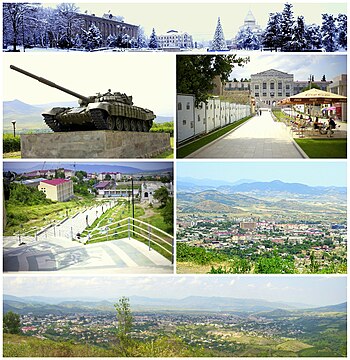Khankendi
|
Stepanakert Ստեփանակերտ Step'anakert |
||
|---|---|---|
| City | ||

From top left:
Panoramic view of the Renaissance Square T-72 tank memorial of Karabakh War • Artsakh University Downtown Stepanakert • Stepanakert skyline Panoramic view of Stepanakert |
||
|
||
| Location of Stepanakert in Nagorno-Karabakh. | ||
| Coordinates: 39°48′55″N 46°45′7″E / 39.81528°N 46.75194°ECoordinates: 39°48′55″N 46°45′7″E / 39.81528°N 46.75194°E | ||
| Country |
|
|
| Province | Stepanakert | |
| City status | 1923 | |
| Government | ||
| • Type | Mayor–Council | |
| • Body | Stepanakert City Council | |
| • Mayor of Stepanakert | Suren Grigoryan | |
| Area | ||
| • Total | 29.12 km2 (11.24 sq mi) | |
| Elevation | 813 m (2,670 ft) | |
| Population (2015) | ||
| • Total | 55,200 | |
| • Density | 1,872/km2 (4,850/sq mi) | |
| Time zone | GMT+4 (UTC+4) | |
| Area code(s) | +374 47 | |
| Website | stepanakert |
|
| Sources: Stepanakert city area and population | ||
| Year | Armenians | Azerbaijanis | Others | TOTAL | |||
|---|---|---|---|---|---|---|---|
| 1926 |
|
|
|
|
|
|
|
| 1939 |
|
|
|
|
|
|
|
| 1959 |
|
|
|
|
|
|
|
| 1970 |
|
|
|
|
|
|
|
| 1979 |
|
|
|
|
|
|
|
| 1989 |
|
|
|
|
|
|
|
| 2005 |
|
|
|
|
|
|
|
| 2010 |
|
|
|
||||
| 2013 |
|
|
|
||||
| 2015 |
|
|
|
||||
Stepanakert (Armenian: Ստեփանակերտ Step'anakert; Eastern Armenian pronunciation: [əstɛpʰanaˈkɛɾt]) or Khankendi (Azerbaijani: Xankəndi), originally called Vararakn (Armenian: Վարարակն), is the capital and the largest city of the Nagorno-Karabakh Republic, a de facto independent republic, recognized as de jure part of Azerbaijan. As of 2015, the population of Stepanakert is 55,200.
Stepanakert meaning the city of Stepan is named after the Armenian Bolshevik revolutionary Stepan Shaumian. The name is formed of the words Stepan (Armenian: Ստեփան) and kert (Armenian: կերտ) meaning town.
According to medieval Armenian sources, the settlement was first mentioned as Vararakn (Վարարակն, meaning "rapid spring" in Armenian), a name that remained in use until 1847, when it was renamed Khankendi. Azerbaijani sources generally say that the settlement was founded in the late eighteenth century as a private residence for khans of the Karabakh Khanate, and was thus called Khankendi (Turkic for "the khan's village"). The settlement was initially called Khanin Kendi (Xanın kəndi), but then was shortened to Khankendi. After the Russian Empire gained the territory of the Karabakh Khanate through the Russo-Persian War of 1804-1813, the name Khankendi was charted on Russian maps.
...
Wikipedia


